Global Marketing Strategies for Technology One in the Mexican Market
VerifiedAdded on 2019/11/12
|13
|3511
|129
Report
AI Summary
This report examines the global marketing strategies of Technology One, an Australian-based information technology company, with a focus on entering the Mexican market. It begins with an introduction to global marketing and a summary of a previous assignment, likely discussing market opportunities and competitive analysis, potentially in China. The report then delves into the process of market selection, explaining the criteria and stages involved, with a specific rationale for choosing Mexico, highlighting cost advantages, skilled labor, and a favorable business climate. It outlines the company's objectives for entering the Mexican market and explores various alternative market entry strategies, including direct investment, exporting, and partnerships, considering both advantages and challenges. The report also addresses target market selection, analyzing market segmentation and the process of identifying the most suitable customer segments. Finally, it offers recommendations based on the analysis, likely suggesting the most effective strategies for Technology One to successfully establish itself in the Mexican market and achieve its international expansion goals.
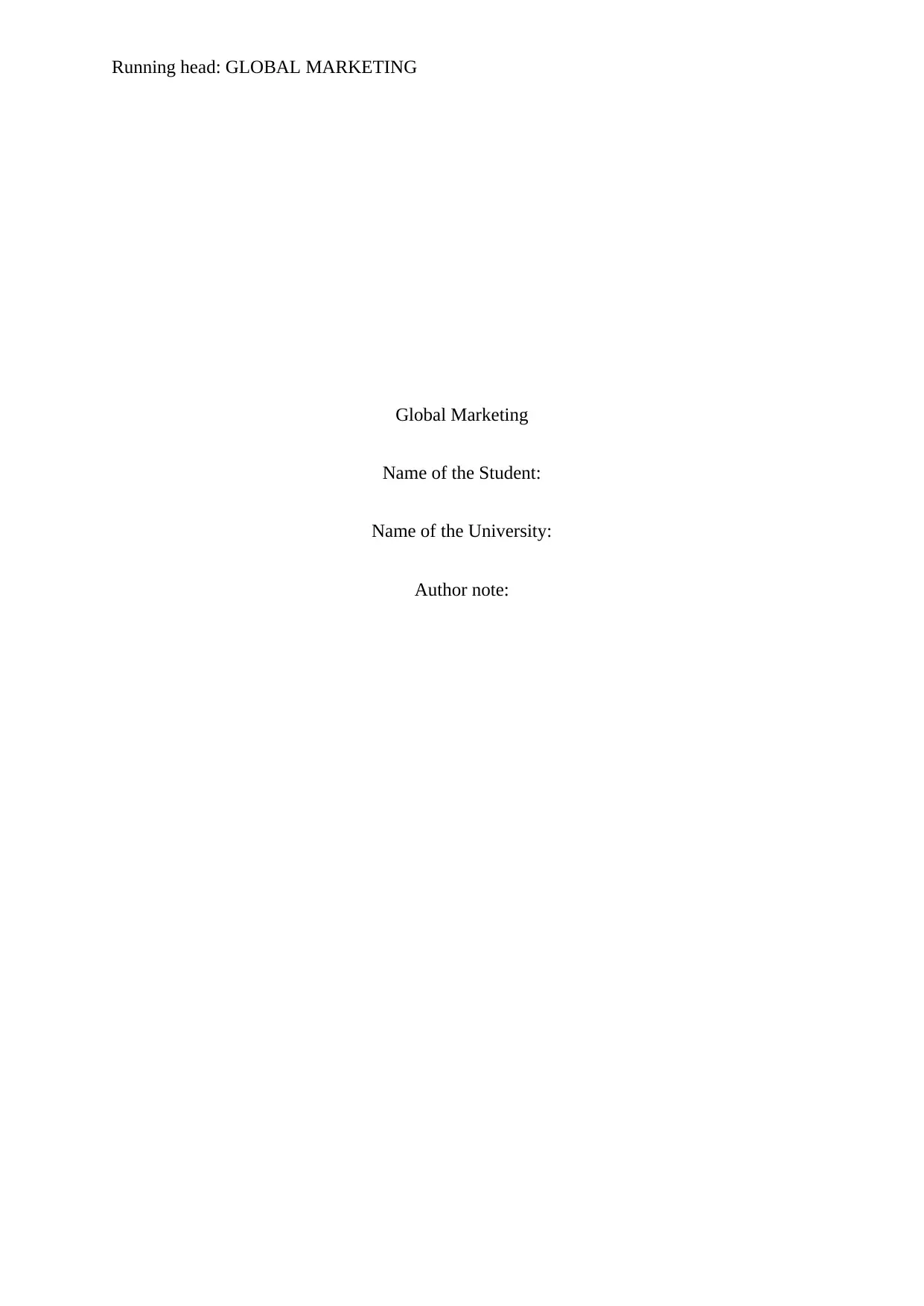
Running head: GLOBAL MARKETING
Global Marketing
Name of the Student:
Name of the University:
Author note:
Global Marketing
Name of the Student:
Name of the University:
Author note:
Paraphrase This Document
Need a fresh take? Get an instant paraphrase of this document with our AI Paraphraser
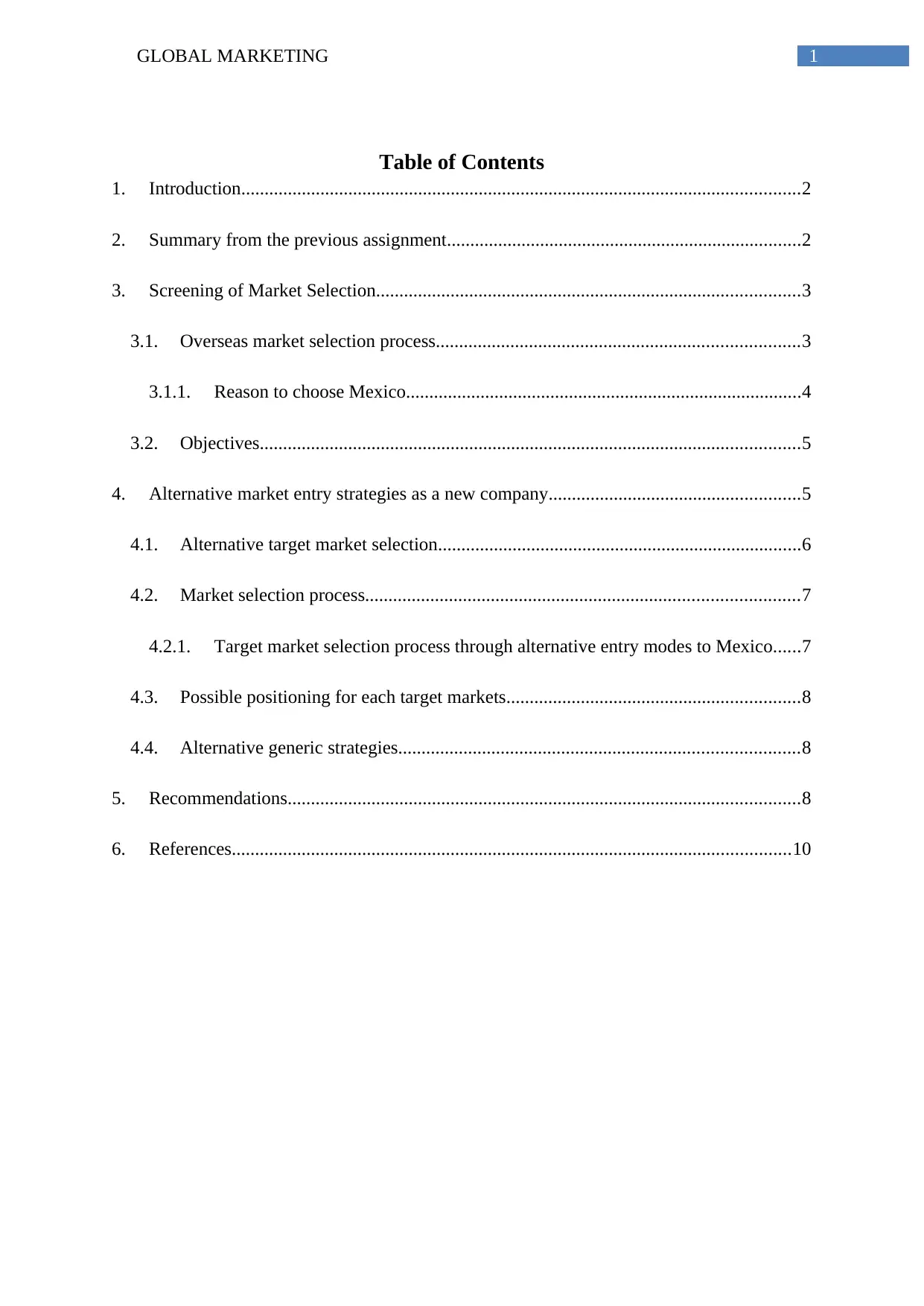
1GLOBAL MARKETING
Table of Contents
1. Introduction........................................................................................................................2
2. Summary from the previous assignment............................................................................2
3. Screening of Market Selection...........................................................................................3
3.1. Overseas market selection process..............................................................................3
3.1.1. Reason to choose Mexico.....................................................................................4
3.2. Objectives....................................................................................................................5
4. Alternative market entry strategies as a new company......................................................5
4.1. Alternative target market selection..............................................................................6
4.2. Market selection process.............................................................................................7
4.2.1. Target market selection process through alternative entry modes to Mexico......7
4.3. Possible positioning for each target markets...............................................................8
4.4. Alternative generic strategies......................................................................................8
5. Recommendations..............................................................................................................8
6. References........................................................................................................................10
Table of Contents
1. Introduction........................................................................................................................2
2. Summary from the previous assignment............................................................................2
3. Screening of Market Selection...........................................................................................3
3.1. Overseas market selection process..............................................................................3
3.1.1. Reason to choose Mexico.....................................................................................4
3.2. Objectives....................................................................................................................5
4. Alternative market entry strategies as a new company......................................................5
4.1. Alternative target market selection..............................................................................6
4.2. Market selection process.............................................................................................7
4.2.1. Target market selection process through alternative entry modes to Mexico......7
4.3. Possible positioning for each target markets...............................................................8
4.4. Alternative generic strategies......................................................................................8
5. Recommendations..............................................................................................................8
6. References........................................................................................................................10
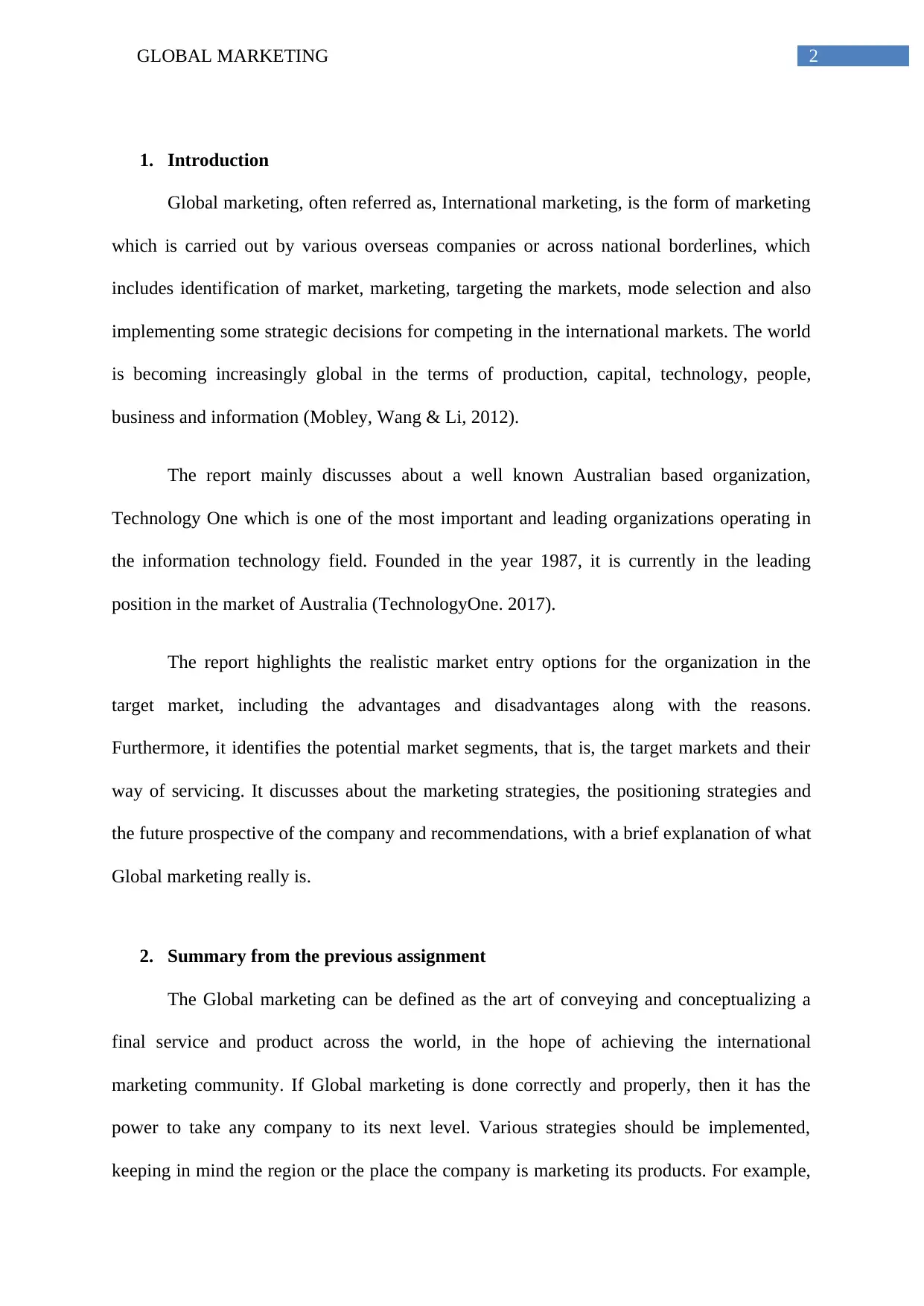
2GLOBAL MARKETING
1. Introduction
Global marketing, often referred as, International marketing, is the form of marketing
which is carried out by various overseas companies or across national borderlines, which
includes identification of market, marketing, targeting the markets, mode selection and also
implementing some strategic decisions for competing in the international markets. The world
is becoming increasingly global in the terms of production, capital, technology, people,
business and information (Mobley, Wang & Li, 2012).
The report mainly discusses about a well known Australian based organization,
Technology One which is one of the most important and leading organizations operating in
the information technology field. Founded in the year 1987, it is currently in the leading
position in the market of Australia (TechnologyOne. 2017).
The report highlights the realistic market entry options for the organization in the
target market, including the advantages and disadvantages along with the reasons.
Furthermore, it identifies the potential market segments, that is, the target markets and their
way of servicing. It discusses about the marketing strategies, the positioning strategies and
the future prospective of the company and recommendations, with a brief explanation of what
Global marketing really is.
2. Summary from the previous assignment
The Global marketing can be defined as the art of conveying and conceptualizing a
final service and product across the world, in the hope of achieving the international
marketing community. If Global marketing is done correctly and properly, then it has the
power to take any company to its next level. Various strategies should be implemented,
keeping in mind the region or the place the company is marketing its products. For example,
1. Introduction
Global marketing, often referred as, International marketing, is the form of marketing
which is carried out by various overseas companies or across national borderlines, which
includes identification of market, marketing, targeting the markets, mode selection and also
implementing some strategic decisions for competing in the international markets. The world
is becoming increasingly global in the terms of production, capital, technology, people,
business and information (Mobley, Wang & Li, 2012).
The report mainly discusses about a well known Australian based organization,
Technology One which is one of the most important and leading organizations operating in
the information technology field. Founded in the year 1987, it is currently in the leading
position in the market of Australia (TechnologyOne. 2017).
The report highlights the realistic market entry options for the organization in the
target market, including the advantages and disadvantages along with the reasons.
Furthermore, it identifies the potential market segments, that is, the target markets and their
way of servicing. It discusses about the marketing strategies, the positioning strategies and
the future prospective of the company and recommendations, with a brief explanation of what
Global marketing really is.
2. Summary from the previous assignment
The Global marketing can be defined as the art of conveying and conceptualizing a
final service and product across the world, in the hope of achieving the international
marketing community. If Global marketing is done correctly and properly, then it has the
power to take any company to its next level. Various strategies should be implemented,
keeping in mind the region or the place the company is marketing its products. For example,
⊘ This is a preview!⊘
Do you want full access?
Subscribe today to unlock all pages.

Trusted by 1+ million students worldwide
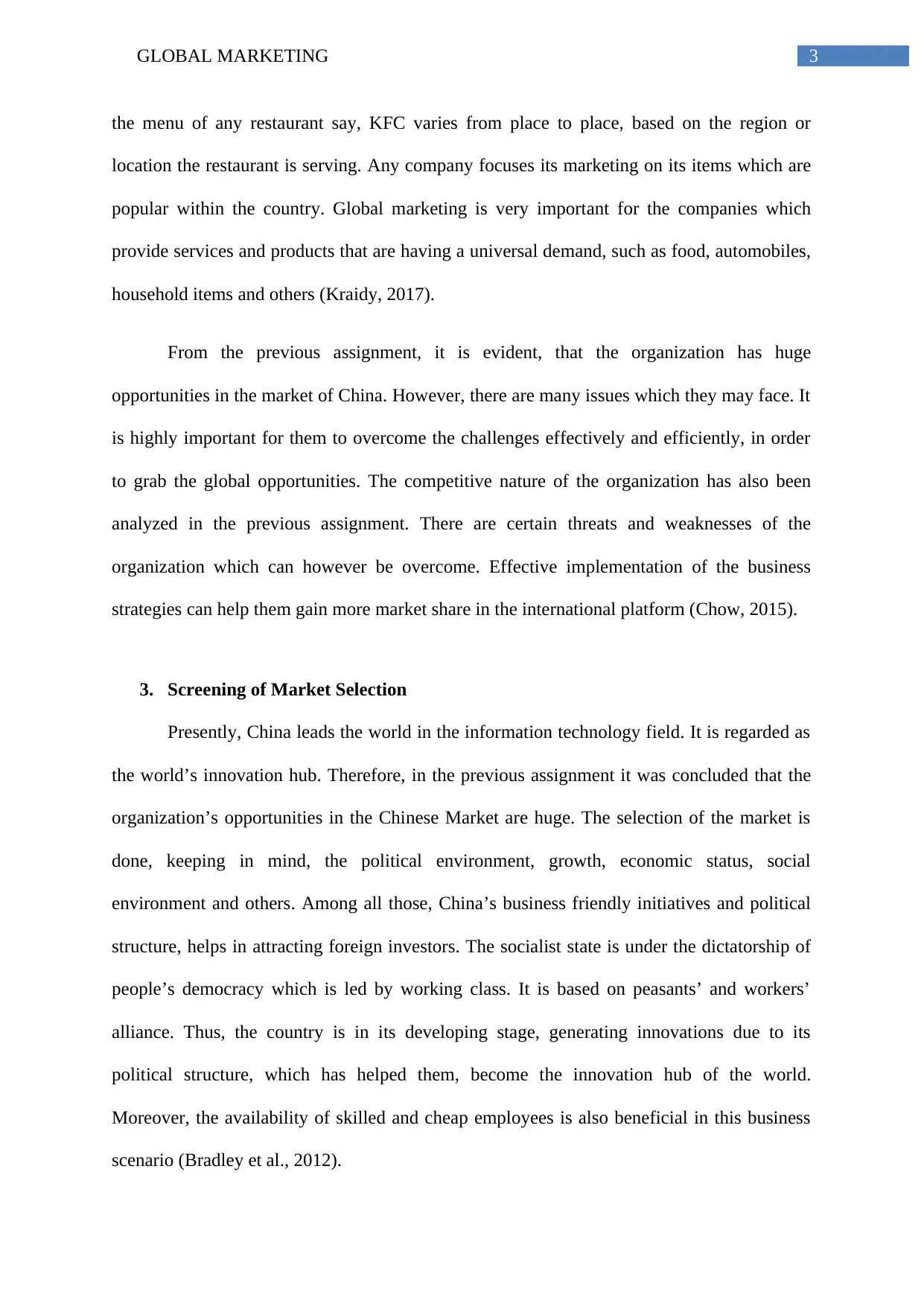
3GLOBAL MARKETING
the menu of any restaurant say, KFC varies from place to place, based on the region or
location the restaurant is serving. Any company focuses its marketing on its items which are
popular within the country. Global marketing is very important for the companies which
provide services and products that are having a universal demand, such as food, automobiles,
household items and others (Kraidy, 2017).
From the previous assignment, it is evident, that the organization has huge
opportunities in the market of China. However, there are many issues which they may face. It
is highly important for them to overcome the challenges effectively and efficiently, in order
to grab the global opportunities. The competitive nature of the organization has also been
analyzed in the previous assignment. There are certain threats and weaknesses of the
organization which can however be overcome. Effective implementation of the business
strategies can help them gain more market share in the international platform (Chow, 2015).
3. Screening of Market Selection
Presently, China leads the world in the information technology field. It is regarded as
the world’s innovation hub. Therefore, in the previous assignment it was concluded that the
organization’s opportunities in the Chinese Market are huge. The selection of the market is
done, keeping in mind, the political environment, growth, economic status, social
environment and others. Among all those, China’s business friendly initiatives and political
structure, helps in attracting foreign investors. The socialist state is under the dictatorship of
people’s democracy which is led by working class. It is based on peasants’ and workers’
alliance. Thus, the country is in its developing stage, generating innovations due to its
political structure, which has helped them, become the innovation hub of the world.
Moreover, the availability of skilled and cheap employees is also beneficial in this business
scenario (Bradley et al., 2012).
the menu of any restaurant say, KFC varies from place to place, based on the region or
location the restaurant is serving. Any company focuses its marketing on its items which are
popular within the country. Global marketing is very important for the companies which
provide services and products that are having a universal demand, such as food, automobiles,
household items and others (Kraidy, 2017).
From the previous assignment, it is evident, that the organization has huge
opportunities in the market of China. However, there are many issues which they may face. It
is highly important for them to overcome the challenges effectively and efficiently, in order
to grab the global opportunities. The competitive nature of the organization has also been
analyzed in the previous assignment. There are certain threats and weaknesses of the
organization which can however be overcome. Effective implementation of the business
strategies can help them gain more market share in the international platform (Chow, 2015).
3. Screening of Market Selection
Presently, China leads the world in the information technology field. It is regarded as
the world’s innovation hub. Therefore, in the previous assignment it was concluded that the
organization’s opportunities in the Chinese Market are huge. The selection of the market is
done, keeping in mind, the political environment, growth, economic status, social
environment and others. Among all those, China’s business friendly initiatives and political
structure, helps in attracting foreign investors. The socialist state is under the dictatorship of
people’s democracy which is led by working class. It is based on peasants’ and workers’
alliance. Thus, the country is in its developing stage, generating innovations due to its
political structure, which has helped them, become the innovation hub of the world.
Moreover, the availability of skilled and cheap employees is also beneficial in this business
scenario (Bradley et al., 2012).
Paraphrase This Document
Need a fresh take? Get an instant paraphrase of this document with our AI Paraphraser
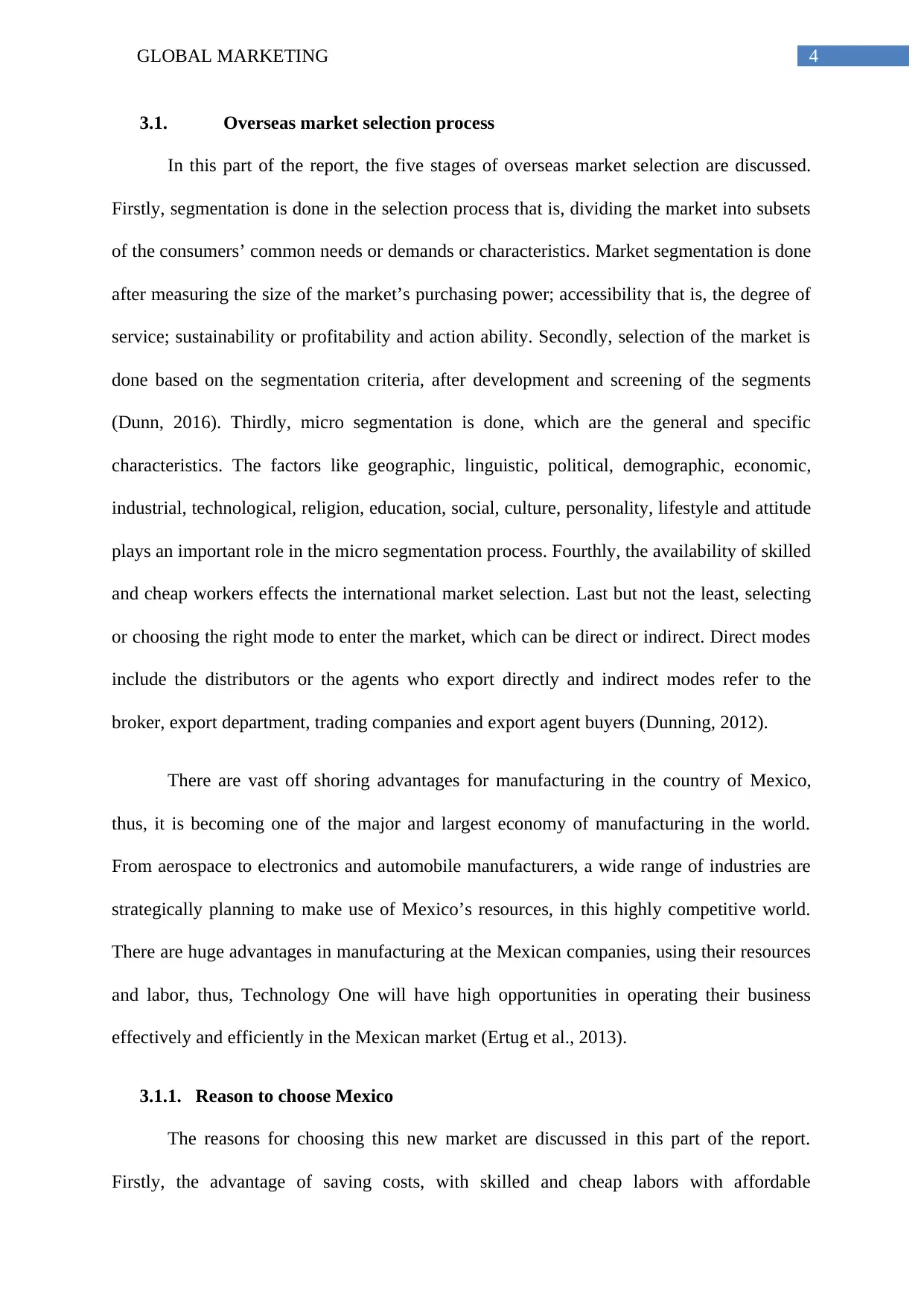
4GLOBAL MARKETING
3.1. Overseas market selection process
In this part of the report, the five stages of overseas market selection are discussed.
Firstly, segmentation is done in the selection process that is, dividing the market into subsets
of the consumers’ common needs or demands or characteristics. Market segmentation is done
after measuring the size of the market’s purchasing power; accessibility that is, the degree of
service; sustainability or profitability and action ability. Secondly, selection of the market is
done based on the segmentation criteria, after development and screening of the segments
(Dunn, 2016). Thirdly, micro segmentation is done, which are the general and specific
characteristics. The factors like geographic, linguistic, political, demographic, economic,
industrial, technological, religion, education, social, culture, personality, lifestyle and attitude
plays an important role in the micro segmentation process. Fourthly, the availability of skilled
and cheap workers effects the international market selection. Last but not the least, selecting
or choosing the right mode to enter the market, which can be direct or indirect. Direct modes
include the distributors or the agents who export directly and indirect modes refer to the
broker, export department, trading companies and export agent buyers (Dunning, 2012).
There are vast off shoring advantages for manufacturing in the country of Mexico,
thus, it is becoming one of the major and largest economy of manufacturing in the world.
From aerospace to electronics and automobile manufacturers, a wide range of industries are
strategically planning to make use of Mexico’s resources, in this highly competitive world.
There are huge advantages in manufacturing at the Mexican companies, using their resources
and labor, thus, Technology One will have high opportunities in operating their business
effectively and efficiently in the Mexican market (Ertug et al., 2013).
3.1.1. Reason to choose Mexico
The reasons for choosing this new market are discussed in this part of the report.
Firstly, the advantage of saving costs, with skilled and cheap labors with affordable
3.1. Overseas market selection process
In this part of the report, the five stages of overseas market selection are discussed.
Firstly, segmentation is done in the selection process that is, dividing the market into subsets
of the consumers’ common needs or demands or characteristics. Market segmentation is done
after measuring the size of the market’s purchasing power; accessibility that is, the degree of
service; sustainability or profitability and action ability. Secondly, selection of the market is
done based on the segmentation criteria, after development and screening of the segments
(Dunn, 2016). Thirdly, micro segmentation is done, which are the general and specific
characteristics. The factors like geographic, linguistic, political, demographic, economic,
industrial, technological, religion, education, social, culture, personality, lifestyle and attitude
plays an important role in the micro segmentation process. Fourthly, the availability of skilled
and cheap workers effects the international market selection. Last but not the least, selecting
or choosing the right mode to enter the market, which can be direct or indirect. Direct modes
include the distributors or the agents who export directly and indirect modes refer to the
broker, export department, trading companies and export agent buyers (Dunning, 2012).
There are vast off shoring advantages for manufacturing in the country of Mexico,
thus, it is becoming one of the major and largest economy of manufacturing in the world.
From aerospace to electronics and automobile manufacturers, a wide range of industries are
strategically planning to make use of Mexico’s resources, in this highly competitive world.
There are huge advantages in manufacturing at the Mexican companies, using their resources
and labor, thus, Technology One will have high opportunities in operating their business
effectively and efficiently in the Mexican market (Ertug et al., 2013).
3.1.1. Reason to choose Mexico
The reasons for choosing this new market are discussed in this part of the report.
Firstly, the advantage of saving costs, with skilled and cheap labors with affordable
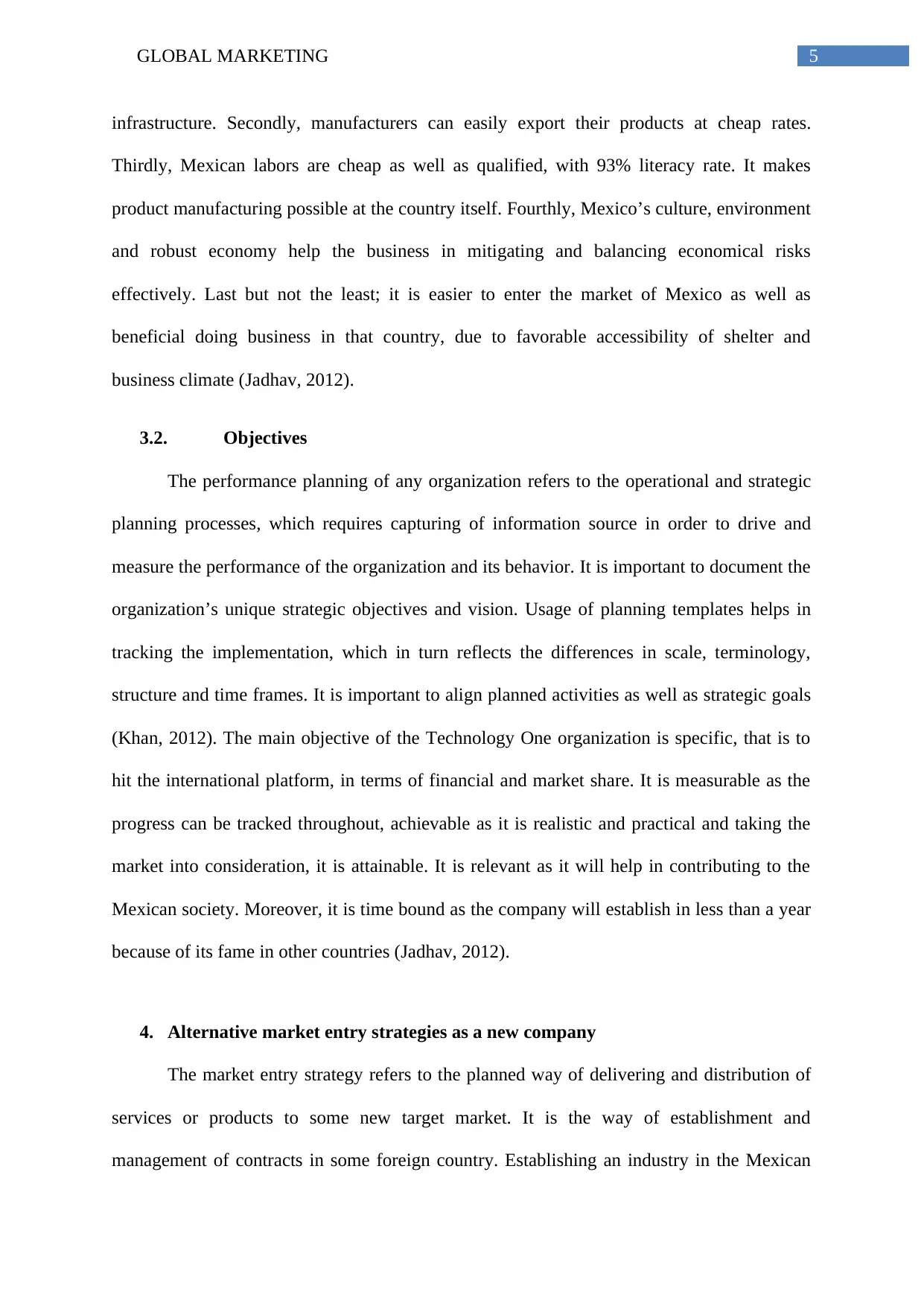
5GLOBAL MARKETING
infrastructure. Secondly, manufacturers can easily export their products at cheap rates.
Thirdly, Mexican labors are cheap as well as qualified, with 93% literacy rate. It makes
product manufacturing possible at the country itself. Fourthly, Mexico’s culture, environment
and robust economy help the business in mitigating and balancing economical risks
effectively. Last but not the least; it is easier to enter the market of Mexico as well as
beneficial doing business in that country, due to favorable accessibility of shelter and
business climate (Jadhav, 2012).
3.2. Objectives
The performance planning of any organization refers to the operational and strategic
planning processes, which requires capturing of information source in order to drive and
measure the performance of the organization and its behavior. It is important to document the
organization’s unique strategic objectives and vision. Usage of planning templates helps in
tracking the implementation, which in turn reflects the differences in scale, terminology,
structure and time frames. It is important to align planned activities as well as strategic goals
(Khan, 2012). The main objective of the Technology One organization is specific, that is to
hit the international platform, in terms of financial and market share. It is measurable as the
progress can be tracked throughout, achievable as it is realistic and practical and taking the
market into consideration, it is attainable. It is relevant as it will help in contributing to the
Mexican society. Moreover, it is time bound as the company will establish in less than a year
because of its fame in other countries (Jadhav, 2012).
4. Alternative market entry strategies as a new company
The market entry strategy refers to the planned way of delivering and distribution of
services or products to some new target market. It is the way of establishment and
management of contracts in some foreign country. Establishing an industry in the Mexican
infrastructure. Secondly, manufacturers can easily export their products at cheap rates.
Thirdly, Mexican labors are cheap as well as qualified, with 93% literacy rate. It makes
product manufacturing possible at the country itself. Fourthly, Mexico’s culture, environment
and robust economy help the business in mitigating and balancing economical risks
effectively. Last but not the least; it is easier to enter the market of Mexico as well as
beneficial doing business in that country, due to favorable accessibility of shelter and
business climate (Jadhav, 2012).
3.2. Objectives
The performance planning of any organization refers to the operational and strategic
planning processes, which requires capturing of information source in order to drive and
measure the performance of the organization and its behavior. It is important to document the
organization’s unique strategic objectives and vision. Usage of planning templates helps in
tracking the implementation, which in turn reflects the differences in scale, terminology,
structure and time frames. It is important to align planned activities as well as strategic goals
(Khan, 2012). The main objective of the Technology One organization is specific, that is to
hit the international platform, in terms of financial and market share. It is measurable as the
progress can be tracked throughout, achievable as it is realistic and practical and taking the
market into consideration, it is attainable. It is relevant as it will help in contributing to the
Mexican society. Moreover, it is time bound as the company will establish in less than a year
because of its fame in other countries (Jadhav, 2012).
4. Alternative market entry strategies as a new company
The market entry strategy refers to the planned way of delivering and distribution of
services or products to some new target market. It is the way of establishment and
management of contracts in some foreign country. Establishing an industry in the Mexican
⊘ This is a preview!⊘
Do you want full access?
Subscribe today to unlock all pages.

Trusted by 1+ million students worldwide
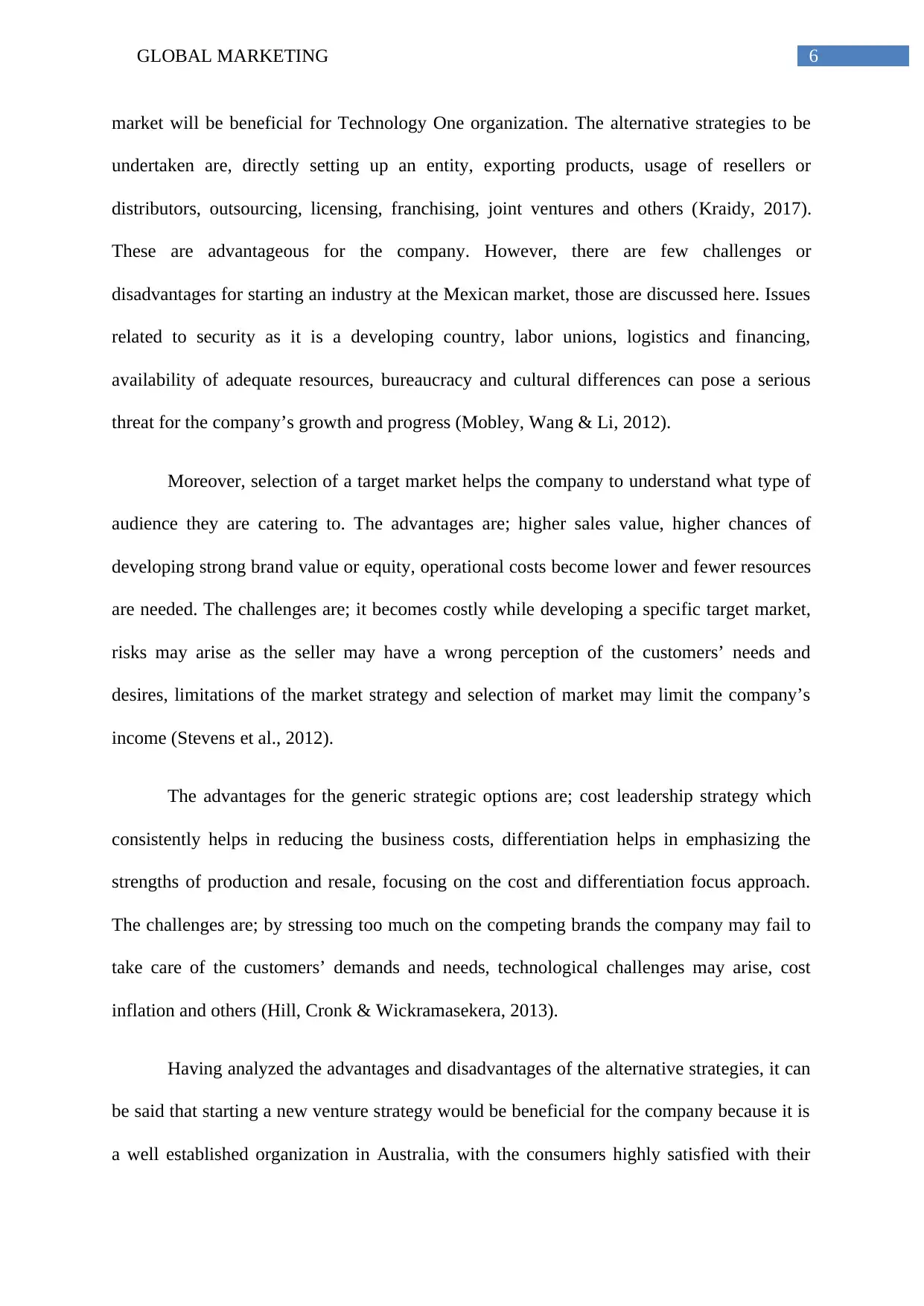
6GLOBAL MARKETING
market will be beneficial for Technology One organization. The alternative strategies to be
undertaken are, directly setting up an entity, exporting products, usage of resellers or
distributors, outsourcing, licensing, franchising, joint ventures and others (Kraidy, 2017).
These are advantageous for the company. However, there are few challenges or
disadvantages for starting an industry at the Mexican market, those are discussed here. Issues
related to security as it is a developing country, labor unions, logistics and financing,
availability of adequate resources, bureaucracy and cultural differences can pose a serious
threat for the company’s growth and progress (Mobley, Wang & Li, 2012).
Moreover, selection of a target market helps the company to understand what type of
audience they are catering to. The advantages are; higher sales value, higher chances of
developing strong brand value or equity, operational costs become lower and fewer resources
are needed. The challenges are; it becomes costly while developing a specific target market,
risks may arise as the seller may have a wrong perception of the customers’ needs and
desires, limitations of the market strategy and selection of market may limit the company’s
income (Stevens et al., 2012).
The advantages for the generic strategic options are; cost leadership strategy which
consistently helps in reducing the business costs, differentiation helps in emphasizing the
strengths of production and resale, focusing on the cost and differentiation focus approach.
The challenges are; by stressing too much on the competing brands the company may fail to
take care of the customers’ demands and needs, technological challenges may arise, cost
inflation and others (Hill, Cronk & Wickramasekera, 2013).
Having analyzed the advantages and disadvantages of the alternative strategies, it can
be said that starting a new venture strategy would be beneficial for the company because it is
a well established organization in Australia, with the consumers highly satisfied with their
market will be beneficial for Technology One organization. The alternative strategies to be
undertaken are, directly setting up an entity, exporting products, usage of resellers or
distributors, outsourcing, licensing, franchising, joint ventures and others (Kraidy, 2017).
These are advantageous for the company. However, there are few challenges or
disadvantages for starting an industry at the Mexican market, those are discussed here. Issues
related to security as it is a developing country, labor unions, logistics and financing,
availability of adequate resources, bureaucracy and cultural differences can pose a serious
threat for the company’s growth and progress (Mobley, Wang & Li, 2012).
Moreover, selection of a target market helps the company to understand what type of
audience they are catering to. The advantages are; higher sales value, higher chances of
developing strong brand value or equity, operational costs become lower and fewer resources
are needed. The challenges are; it becomes costly while developing a specific target market,
risks may arise as the seller may have a wrong perception of the customers’ needs and
desires, limitations of the market strategy and selection of market may limit the company’s
income (Stevens et al., 2012).
The advantages for the generic strategic options are; cost leadership strategy which
consistently helps in reducing the business costs, differentiation helps in emphasizing the
strengths of production and resale, focusing on the cost and differentiation focus approach.
The challenges are; by stressing too much on the competing brands the company may fail to
take care of the customers’ demands and needs, technological challenges may arise, cost
inflation and others (Hill, Cronk & Wickramasekera, 2013).
Having analyzed the advantages and disadvantages of the alternative strategies, it can
be said that starting a new venture strategy would be beneficial for the company because it is
a well established organization in Australia, with the consumers highly satisfied with their
Paraphrase This Document
Need a fresh take? Get an instant paraphrase of this document with our AI Paraphraser
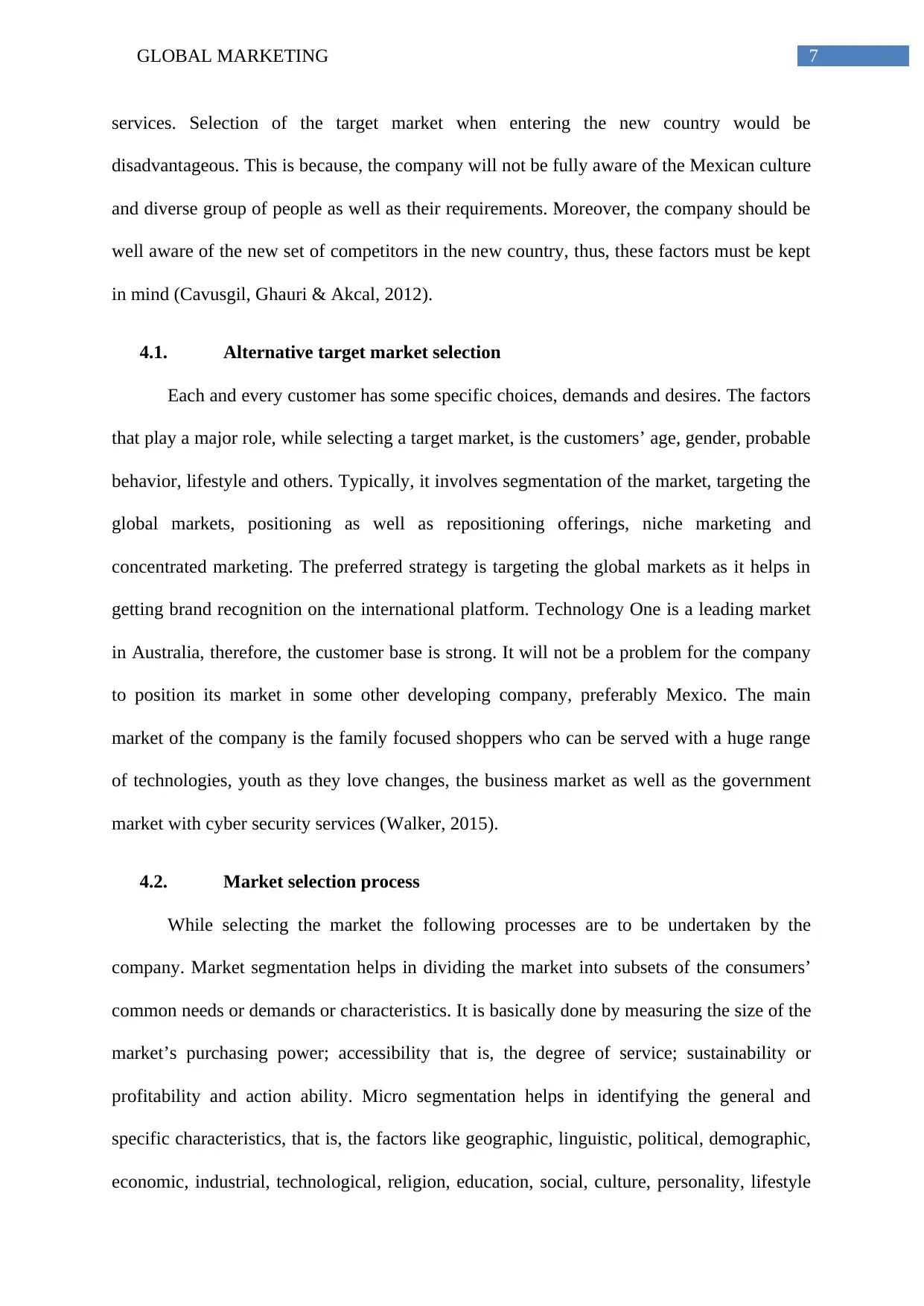
7GLOBAL MARKETING
services. Selection of the target market when entering the new country would be
disadvantageous. This is because, the company will not be fully aware of the Mexican culture
and diverse group of people as well as their requirements. Moreover, the company should be
well aware of the new set of competitors in the new country, thus, these factors must be kept
in mind (Cavusgil, Ghauri & Akcal, 2012).
4.1. Alternative target market selection
Each and every customer has some specific choices, demands and desires. The factors
that play a major role, while selecting a target market, is the customers’ age, gender, probable
behavior, lifestyle and others. Typically, it involves segmentation of the market, targeting the
global markets, positioning as well as repositioning offerings, niche marketing and
concentrated marketing. The preferred strategy is targeting the global markets as it helps in
getting brand recognition on the international platform. Technology One is a leading market
in Australia, therefore, the customer base is strong. It will not be a problem for the company
to position its market in some other developing company, preferably Mexico. The main
market of the company is the family focused shoppers who can be served with a huge range
of technologies, youth as they love changes, the business market as well as the government
market with cyber security services (Walker, 2015).
4.2. Market selection process
While selecting the market the following processes are to be undertaken by the
company. Market segmentation helps in dividing the market into subsets of the consumers’
common needs or demands or characteristics. It is basically done by measuring the size of the
market’s purchasing power; accessibility that is, the degree of service; sustainability or
profitability and action ability. Micro segmentation helps in identifying the general and
specific characteristics, that is, the factors like geographic, linguistic, political, demographic,
economic, industrial, technological, religion, education, social, culture, personality, lifestyle
services. Selection of the target market when entering the new country would be
disadvantageous. This is because, the company will not be fully aware of the Mexican culture
and diverse group of people as well as their requirements. Moreover, the company should be
well aware of the new set of competitors in the new country, thus, these factors must be kept
in mind (Cavusgil, Ghauri & Akcal, 2012).
4.1. Alternative target market selection
Each and every customer has some specific choices, demands and desires. The factors
that play a major role, while selecting a target market, is the customers’ age, gender, probable
behavior, lifestyle and others. Typically, it involves segmentation of the market, targeting the
global markets, positioning as well as repositioning offerings, niche marketing and
concentrated marketing. The preferred strategy is targeting the global markets as it helps in
getting brand recognition on the international platform. Technology One is a leading market
in Australia, therefore, the customer base is strong. It will not be a problem for the company
to position its market in some other developing company, preferably Mexico. The main
market of the company is the family focused shoppers who can be served with a huge range
of technologies, youth as they love changes, the business market as well as the government
market with cyber security services (Walker, 2015).
4.2. Market selection process
While selecting the market the following processes are to be undertaken by the
company. Market segmentation helps in dividing the market into subsets of the consumers’
common needs or demands or characteristics. It is basically done by measuring the size of the
market’s purchasing power; accessibility that is, the degree of service; sustainability or
profitability and action ability. Micro segmentation helps in identifying the general and
specific characteristics, that is, the factors like geographic, linguistic, political, demographic,
economic, industrial, technological, religion, education, social, culture, personality, lifestyle
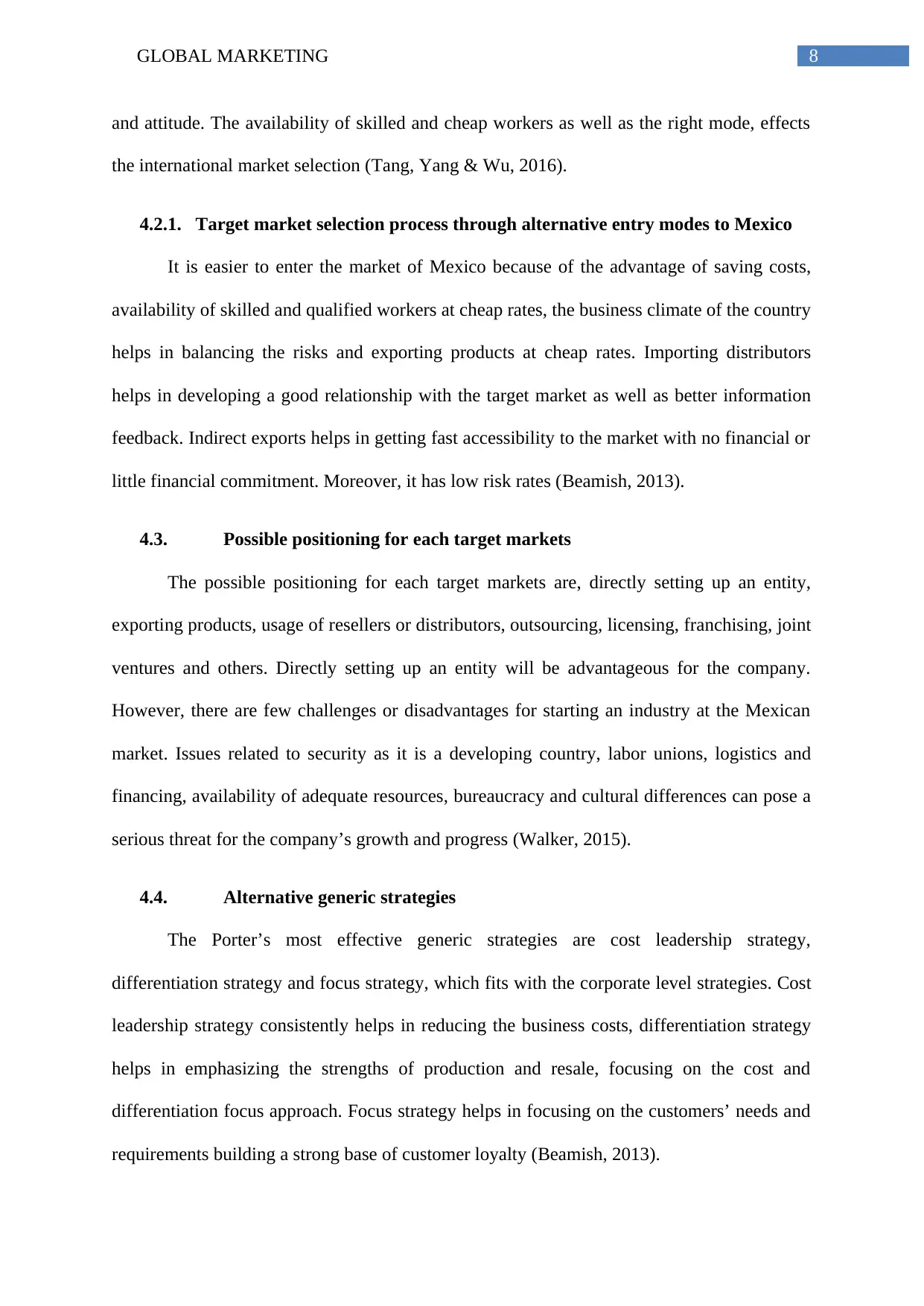
8GLOBAL MARKETING
and attitude. The availability of skilled and cheap workers as well as the right mode, effects
the international market selection (Tang, Yang & Wu, 2016).
4.2.1. Target market selection process through alternative entry modes to Mexico
It is easier to enter the market of Mexico because of the advantage of saving costs,
availability of skilled and qualified workers at cheap rates, the business climate of the country
helps in balancing the risks and exporting products at cheap rates. Importing distributors
helps in developing a good relationship with the target market as well as better information
feedback. Indirect exports helps in getting fast accessibility to the market with no financial or
little financial commitment. Moreover, it has low risk rates (Beamish, 2013).
4.3. Possible positioning for each target markets
The possible positioning for each target markets are, directly setting up an entity,
exporting products, usage of resellers or distributors, outsourcing, licensing, franchising, joint
ventures and others. Directly setting up an entity will be advantageous for the company.
However, there are few challenges or disadvantages for starting an industry at the Mexican
market. Issues related to security as it is a developing country, labor unions, logistics and
financing, availability of adequate resources, bureaucracy and cultural differences can pose a
serious threat for the company’s growth and progress (Walker, 2015).
4.4. Alternative generic strategies
The Porter’s most effective generic strategies are cost leadership strategy,
differentiation strategy and focus strategy, which fits with the corporate level strategies. Cost
leadership strategy consistently helps in reducing the business costs, differentiation strategy
helps in emphasizing the strengths of production and resale, focusing on the cost and
differentiation focus approach. Focus strategy helps in focusing on the customers’ needs and
requirements building a strong base of customer loyalty (Beamish, 2013).
and attitude. The availability of skilled and cheap workers as well as the right mode, effects
the international market selection (Tang, Yang & Wu, 2016).
4.2.1. Target market selection process through alternative entry modes to Mexico
It is easier to enter the market of Mexico because of the advantage of saving costs,
availability of skilled and qualified workers at cheap rates, the business climate of the country
helps in balancing the risks and exporting products at cheap rates. Importing distributors
helps in developing a good relationship with the target market as well as better information
feedback. Indirect exports helps in getting fast accessibility to the market with no financial or
little financial commitment. Moreover, it has low risk rates (Beamish, 2013).
4.3. Possible positioning for each target markets
The possible positioning for each target markets are, directly setting up an entity,
exporting products, usage of resellers or distributors, outsourcing, licensing, franchising, joint
ventures and others. Directly setting up an entity will be advantageous for the company.
However, there are few challenges or disadvantages for starting an industry at the Mexican
market. Issues related to security as it is a developing country, labor unions, logistics and
financing, availability of adequate resources, bureaucracy and cultural differences can pose a
serious threat for the company’s growth and progress (Walker, 2015).
4.4. Alternative generic strategies
The Porter’s most effective generic strategies are cost leadership strategy,
differentiation strategy and focus strategy, which fits with the corporate level strategies. Cost
leadership strategy consistently helps in reducing the business costs, differentiation strategy
helps in emphasizing the strengths of production and resale, focusing on the cost and
differentiation focus approach. Focus strategy helps in focusing on the customers’ needs and
requirements building a strong base of customer loyalty (Beamish, 2013).
⊘ This is a preview!⊘
Do you want full access?
Subscribe today to unlock all pages.

Trusted by 1+ million students worldwide
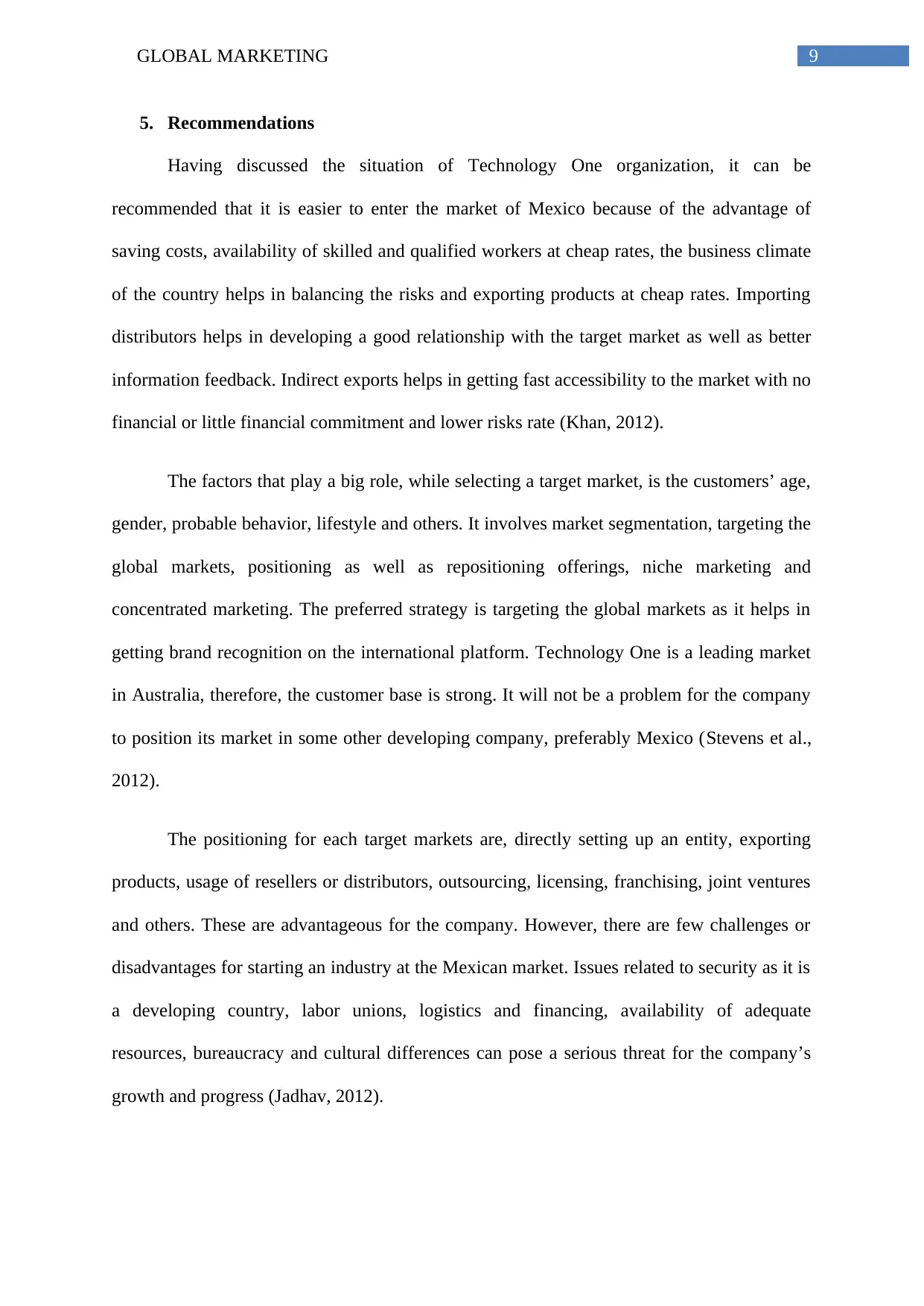
9GLOBAL MARKETING
5. Recommendations
Having discussed the situation of Technology One organization, it can be
recommended that it is easier to enter the market of Mexico because of the advantage of
saving costs, availability of skilled and qualified workers at cheap rates, the business climate
of the country helps in balancing the risks and exporting products at cheap rates. Importing
distributors helps in developing a good relationship with the target market as well as better
information feedback. Indirect exports helps in getting fast accessibility to the market with no
financial or little financial commitment and lower risks rate (Khan, 2012).
The factors that play a big role, while selecting a target market, is the customers’ age,
gender, probable behavior, lifestyle and others. It involves market segmentation, targeting the
global markets, positioning as well as repositioning offerings, niche marketing and
concentrated marketing. The preferred strategy is targeting the global markets as it helps in
getting brand recognition on the international platform. Technology One is a leading market
in Australia, therefore, the customer base is strong. It will not be a problem for the company
to position its market in some other developing company, preferably Mexico (Stevens et al.,
2012).
The positioning for each target markets are, directly setting up an entity, exporting
products, usage of resellers or distributors, outsourcing, licensing, franchising, joint ventures
and others. These are advantageous for the company. However, there are few challenges or
disadvantages for starting an industry at the Mexican market. Issues related to security as it is
a developing country, labor unions, logistics and financing, availability of adequate
resources, bureaucracy and cultural differences can pose a serious threat for the company’s
growth and progress (Jadhav, 2012).
5. Recommendations
Having discussed the situation of Technology One organization, it can be
recommended that it is easier to enter the market of Mexico because of the advantage of
saving costs, availability of skilled and qualified workers at cheap rates, the business climate
of the country helps in balancing the risks and exporting products at cheap rates. Importing
distributors helps in developing a good relationship with the target market as well as better
information feedback. Indirect exports helps in getting fast accessibility to the market with no
financial or little financial commitment and lower risks rate (Khan, 2012).
The factors that play a big role, while selecting a target market, is the customers’ age,
gender, probable behavior, lifestyle and others. It involves market segmentation, targeting the
global markets, positioning as well as repositioning offerings, niche marketing and
concentrated marketing. The preferred strategy is targeting the global markets as it helps in
getting brand recognition on the international platform. Technology One is a leading market
in Australia, therefore, the customer base is strong. It will not be a problem for the company
to position its market in some other developing company, preferably Mexico (Stevens et al.,
2012).
The positioning for each target markets are, directly setting up an entity, exporting
products, usage of resellers or distributors, outsourcing, licensing, franchising, joint ventures
and others. These are advantageous for the company. However, there are few challenges or
disadvantages for starting an industry at the Mexican market. Issues related to security as it is
a developing country, labor unions, logistics and financing, availability of adequate
resources, bureaucracy and cultural differences can pose a serious threat for the company’s
growth and progress (Jadhav, 2012).
Paraphrase This Document
Need a fresh take? Get an instant paraphrase of this document with our AI Paraphraser
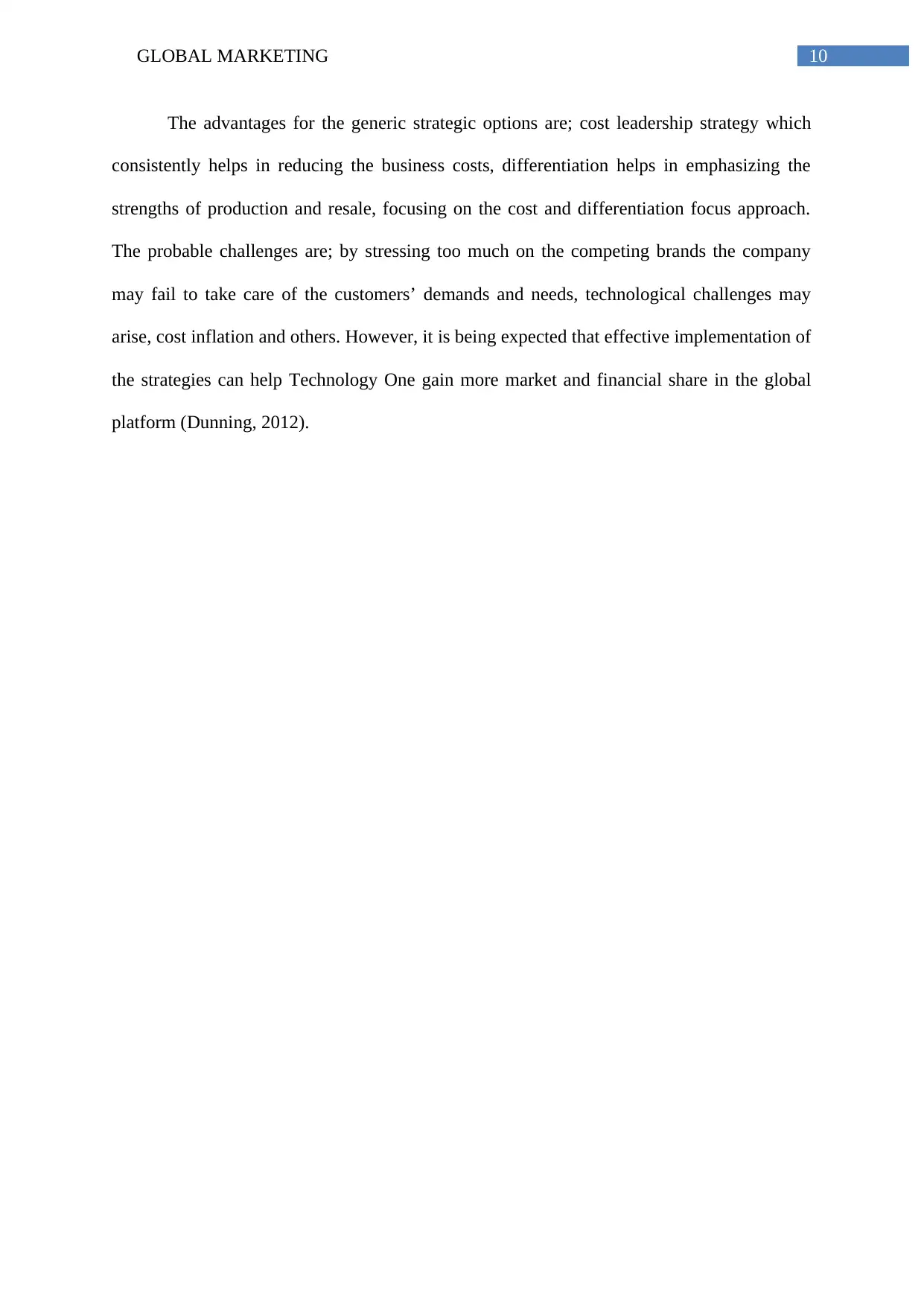
10GLOBAL MARKETING
The advantages for the generic strategic options are; cost leadership strategy which
consistently helps in reducing the business costs, differentiation helps in emphasizing the
strengths of production and resale, focusing on the cost and differentiation focus approach.
The probable challenges are; by stressing too much on the competing brands the company
may fail to take care of the customers’ demands and needs, technological challenges may
arise, cost inflation and others. However, it is being expected that effective implementation of
the strategies can help Technology One gain more market and financial share in the global
platform (Dunning, 2012).
The advantages for the generic strategic options are; cost leadership strategy which
consistently helps in reducing the business costs, differentiation helps in emphasizing the
strengths of production and resale, focusing on the cost and differentiation focus approach.
The probable challenges are; by stressing too much on the competing brands the company
may fail to take care of the customers’ demands and needs, technological challenges may
arise, cost inflation and others. However, it is being expected that effective implementation of
the strategies can help Technology One gain more market and financial share in the global
platform (Dunning, 2012).
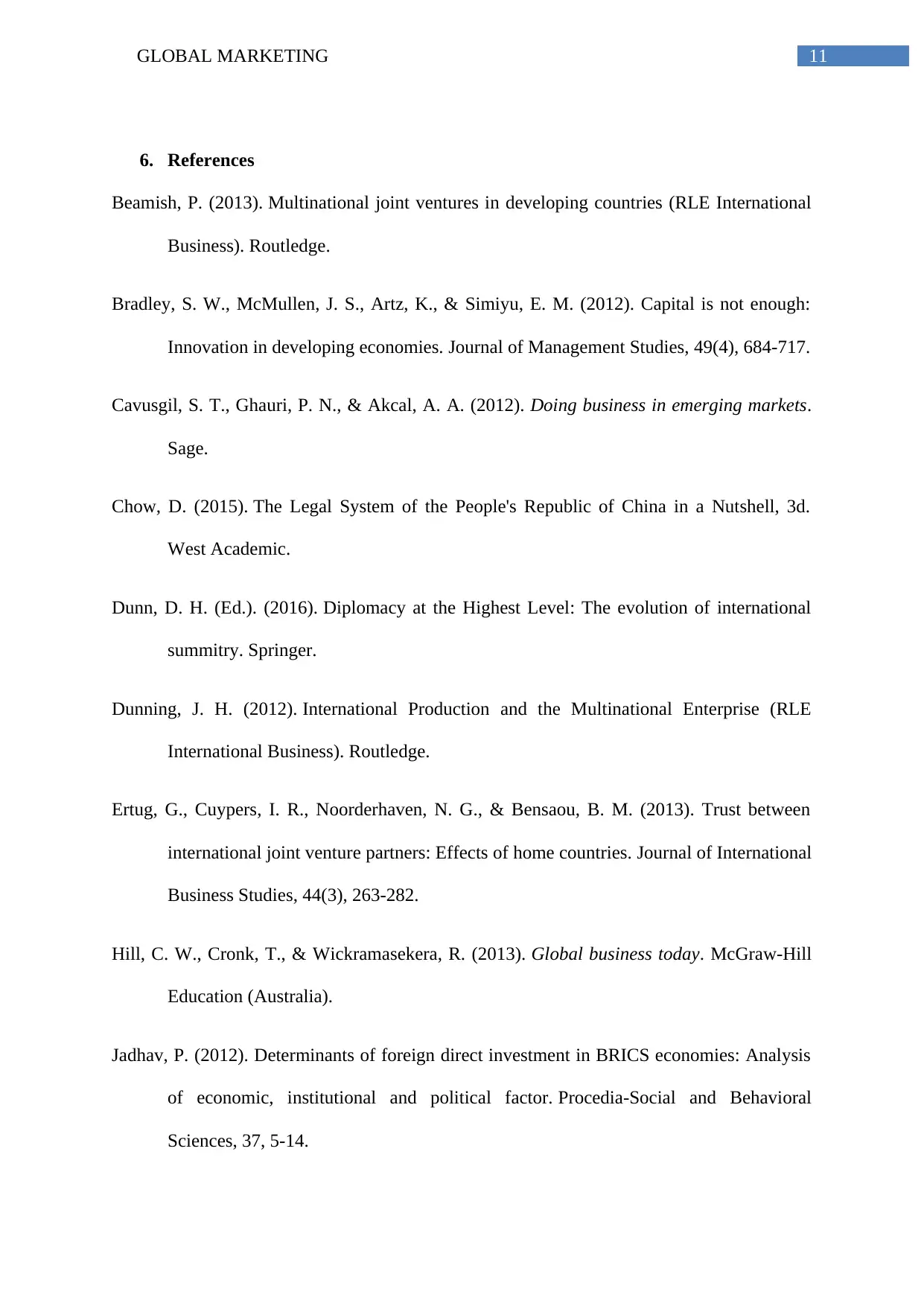
11GLOBAL MARKETING
6. References
Beamish, P. (2013). Multinational joint ventures in developing countries (RLE International
Business). Routledge.
Bradley, S. W., McMullen, J. S., Artz, K., & Simiyu, E. M. (2012). Capital is not enough:
Innovation in developing economies. Journal of Management Studies, 49(4), 684-717.
Cavusgil, S. T., Ghauri, P. N., & Akcal, A. A. (2012). Doing business in emerging markets.
Sage.
Chow, D. (2015). The Legal System of the People's Republic of China in a Nutshell, 3d.
West Academic.
Dunn, D. H. (Ed.). (2016). Diplomacy at the Highest Level: The evolution of international
summitry. Springer.
Dunning, J. H. (2012). International Production and the Multinational Enterprise (RLE
International Business). Routledge.
Ertug, G., Cuypers, I. R., Noorderhaven, N. G., & Bensaou, B. M. (2013). Trust between
international joint venture partners: Effects of home countries. Journal of International
Business Studies, 44(3), 263-282.
Hill, C. W., Cronk, T., & Wickramasekera, R. (2013). Global business today. McGraw-Hill
Education (Australia).
Jadhav, P. (2012). Determinants of foreign direct investment in BRICS economies: Analysis
of economic, institutional and political factor. Procedia-Social and Behavioral
Sciences, 37, 5-14.
6. References
Beamish, P. (2013). Multinational joint ventures in developing countries (RLE International
Business). Routledge.
Bradley, S. W., McMullen, J. S., Artz, K., & Simiyu, E. M. (2012). Capital is not enough:
Innovation in developing economies. Journal of Management Studies, 49(4), 684-717.
Cavusgil, S. T., Ghauri, P. N., & Akcal, A. A. (2012). Doing business in emerging markets.
Sage.
Chow, D. (2015). The Legal System of the People's Republic of China in a Nutshell, 3d.
West Academic.
Dunn, D. H. (Ed.). (2016). Diplomacy at the Highest Level: The evolution of international
summitry. Springer.
Dunning, J. H. (2012). International Production and the Multinational Enterprise (RLE
International Business). Routledge.
Ertug, G., Cuypers, I. R., Noorderhaven, N. G., & Bensaou, B. M. (2013). Trust between
international joint venture partners: Effects of home countries. Journal of International
Business Studies, 44(3), 263-282.
Hill, C. W., Cronk, T., & Wickramasekera, R. (2013). Global business today. McGraw-Hill
Education (Australia).
Jadhav, P. (2012). Determinants of foreign direct investment in BRICS economies: Analysis
of economic, institutional and political factor. Procedia-Social and Behavioral
Sciences, 37, 5-14.
⊘ This is a preview!⊘
Do you want full access?
Subscribe today to unlock all pages.

Trusted by 1+ million students worldwide
1 out of 13
Related Documents
Your All-in-One AI-Powered Toolkit for Academic Success.
+13062052269
info@desklib.com
Available 24*7 on WhatsApp / Email
![[object Object]](/_next/static/media/star-bottom.7253800d.svg)
Unlock your academic potential
Copyright © 2020–2025 A2Z Services. All Rights Reserved. Developed and managed by ZUCOL.





